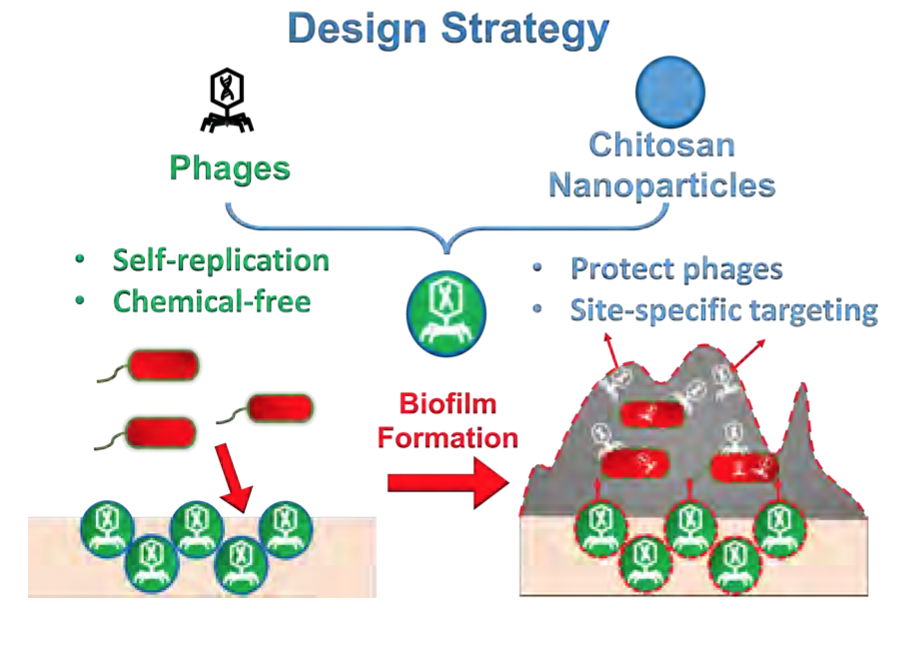NEWT Researchers Eradicate Biofilm and Control Microbial Bacteria Using Phages Conjugated with Superparamagnetic Nanoparticles
Outcome/Accomplishment
The National Science Foundation (NSF)'s Nanosystems Engineering Research Center (ERC) for Nanotechnology Enabled Water Treatment (NEWT), headquartered at Rice University, has developed phage nano-composite conjugates (PNC) encapsulation technology to enable high-precision, site specific, and autonomous biofilm mitigation in water storage systems. By optimizing magnetic nano-phage conjugates (MNPCs), NEWT's work seeks to eradicate biofilm for more selective control of target bacteria.
Impact/Benefits
Biofilms are pervasive and problematic in many water treatment and reuse systems. They can shelter pathogenic or other problematic bacteria, enable multidrug resistant "superbugs," or enhance microbial-induced corrosion. They are especially difficult to eradicate due to hindered penetration of disinfectants. And their associated biofouling can increase the costs and complexity of membrane-based water treatment processes. NEWT's research develops and optimizes superparamagnetic phage-nanoparticle complexes (PNCs) for biofilm eradication and selective control of target bacteria. NEWT's findings further reveal how micropollutants that hinder protein synthesis may adversely influence the efficacy of phage-based biocontrol approaches.
Explanation/Background
NEWT researchers sought to develop a high-throughput approach to screen phages with broad host-range and depolymerase activity. To ensure phage penetration into the biofilm, superparamagnetic nanoparticles (NPs) were conjugated with the phages. The superparamagnetic properties of NPs allow for the migration and penetration of PNCs with a weak magnetic field and the subsequent extraction of the PNCs upon magnetic field withdrawal and washing. By reliably loading the phages onto nanoparticles (NPs) and then modifying the NP surface and size, the researchers could optimize the MNPCs. A goal was to simulate and compare the antifouling capability of different MNPCs under various conditions.
NEWT's new encapsulation technique features an autonomous "smart release" mechanism triggered by bacteria. The team used a simple method to coat plastic surfaces with chitosan encapsulated phages; then, set up a system for biofilm mitigation tests for encapsulated phages in water storage tanks. This combination of phages with nanotechnology results in an alternative chemical-free method to precisely control biofilm formation in a site-specific autonomous manner using inexpensive "green" biocides. The encapsulation technique remains stable for 1 month in tap water and has low pH responsiveness (associated with biofilm localized microenvironments).
Location
Houston, Texaswebsite
Start Year
Energy and Sustainability
Energy, Sustainability, and Infrastructure
Lead Institution
Core Partners
Fact Sheet
Outcome/Accomplishment
The National Science Foundation (NSF)'s Nanosystems Engineering Research Center (ERC) for Nanotechnology Enabled Water Treatment (NEWT), headquartered at Rice University, has developed phage nano-composite conjugates (PNC) encapsulation technology to enable high-precision, site specific, and autonomous biofilm mitigation in water storage systems. By optimizing magnetic nano-phage conjugates (MNPCs), NEWT's work seeks to eradicate biofilm for more selective control of target bacteria.
Location
Houston, Texaswebsite
Start Year
Energy and Sustainability
Energy, Sustainability, and Infrastructure
Lead Institution
Core Partners
Fact Sheet
Impact/benefits
Biofilms are pervasive and problematic in many water treatment and reuse systems. They can shelter pathogenic or other problematic bacteria, enable multidrug resistant "superbugs," or enhance microbial-induced corrosion. They are especially difficult to eradicate due to hindered penetration of disinfectants. And their associated biofouling can increase the costs and complexity of membrane-based water treatment processes. NEWT's research develops and optimizes superparamagnetic phage-nanoparticle complexes (PNCs) for biofilm eradication and selective control of target bacteria. NEWT's findings further reveal how micropollutants that hinder protein synthesis may adversely influence the efficacy of phage-based biocontrol approaches.
Explanation/Background
NEWT researchers sought to develop a high-throughput approach to screen phages with broad host-range and depolymerase activity. To ensure phage penetration into the biofilm, superparamagnetic nanoparticles (NPs) were conjugated with the phages. The superparamagnetic properties of NPs allow for the migration and penetration of PNCs with a weak magnetic field and the subsequent extraction of the PNCs upon magnetic field withdrawal and washing. By reliably loading the phages onto nanoparticles (NPs) and then modifying the NP surface and size, the researchers could optimize the MNPCs. A goal was to simulate and compare the antifouling capability of different MNPCs under various conditions.
NEWT's new encapsulation technique features an autonomous "smart release" mechanism triggered by bacteria. The team used a simple method to coat plastic surfaces with chitosan encapsulated phages; then, set up a system for biofilm mitigation tests for encapsulated phages in water storage tanks. This combination of phages with nanotechnology results in an alternative chemical-free method to precisely control biofilm formation in a site-specific autonomous manner using inexpensive "green" biocides. The encapsulation technique remains stable for 1 month in tap water and has low pH responsiveness (associated with biofilm localized microenvironments).

